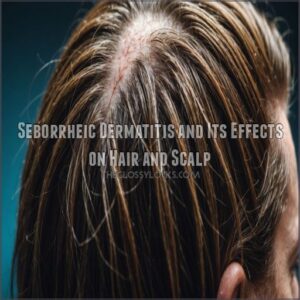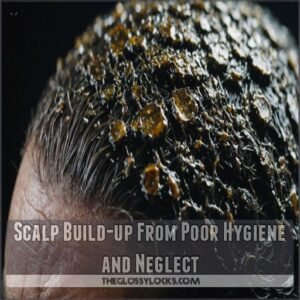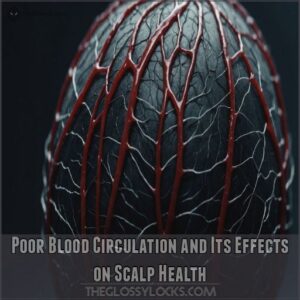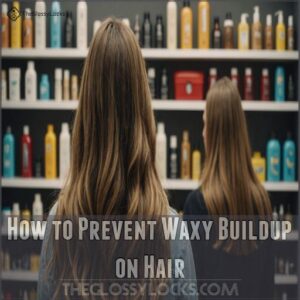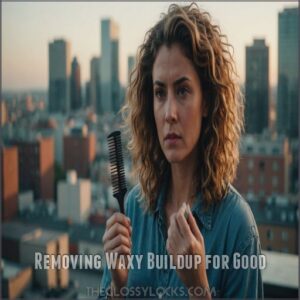This site is supported by our readers. We may earn a commission, at no cost to you, if you purchase through links.
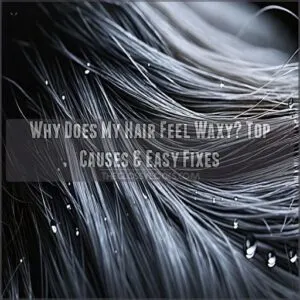 Ever wondered, "Why does my hair feel waxy?" You’re not alone!
Ever wondered, "Why does my hair feel waxy?" You’re not alone!
Several culprits might be behind this sticky situation. Over-processing your hair with chemical treatments can strip natural oils and leave it feeling waxy.
Washing too often might make your scalp cranky and produce extra oil. Did you rinse your shampoo thoroughly? Leftover residue loves to party on your scalp and hair.
Even stress and changes in diet can prank your hair, thanks to seborrheic dermatitis. If you’re nodding along, get ready to explore easy fixes and wave goodbye to that waxy woe.
Curious? There’s more to uncover!
Table Of Contents
- Key Takeaways
- Reasons for Waxy Buildup on Hair
- What Causes Waxy Hair and Scalp Issues
- How to Prevent Waxy Buildup on Hair
- Removing Waxy Buildup for Good
- Frequently Asked Questions (FAQs)
- What causes waxy hair?
- Why is my hair falling out?
- Why does my hair feel waxy after drying?
- Why does my hair feel waxy & sticky?
- How do I get the waxy feeling out of my hair?
- Why does my hair feel waxy even after washing it?
- Why is my hair clean but feels sticky?
- Can water make your hair feel waxy?
- Can diet affect the waxiness of hair?
- Do hair types impact waxy feeling?
- Are there home remedies for waxy hair?
- How often should I exfoliate my scalp?
- Are salon treatments effective for waxy buildup?
- Conclusion
Key Takeaways
- You’re likely dealing with waxy hair due to product buildup, not rinsing thoroughly, or over-processing from chemical treatments, which strip your hair of its natural oils.
- Make sure you’re not washing your hair too frequently, as that strips your hair of its natural oils, causing your scalp to produce more oil, leading to a waxy texture.
- Seborrheic dermatitis, stress, and diet changes can trigger excess oil production, making your hair feel waxy and greasy.
- Use gentle shampoos, avoid harsh chemicals, and consider regular scalp massages and exfoliation to maintain clarity and prevent buildup.
Reasons for Waxy Buildup on Hair
Your hair can feel waxy due to over-processing from chemical treatments, washing too frequently, or not rinsing thoroughly enough after washing.
Each of these factors can strip natural oils or leave product build-up, affecting your hair’s texture and health.
Your Hair is Over-Processed From Chemical Treatments
That waxy feeling in your hair? It might be from over-processing! Frequent salon treatments like bleaching or coloring can damage your hair’s keratin, leading to a waxy texture.
Here’s what to watch out for:
- Noticeable color fading.
- Increased hair breakage.
- Significant hair damage.
Consider a protein treatment to help restore your hair’s health and bounce back from those harsh chemicals.
Remember, less is more when it comes to chemical processing.
You Are Over-Washing Your Hair and Stripping Natural Oils
If washing your hair feels like a daily chore, you might be stripping away its natural oil balance.
Instead of helping, over-washing leads to scalp dryness and boosts oil production.
Try adjusting your shampoo frequency with gentle shampoo options that suit your hair texture.
This simple tweak can transform that waxy feeling into healthy hair care and cleansing.
You Don’t Rinse Your Hair Thoroughly After Washing
While over-washing strips your hair of natural oils, not rinsing thoroughly invites trouble too.
Shampoo residue clings, weighing down your locks and leading to greasy hair and scalp build-up.
It’s like inviting guests over and not showing them the door.
Make sure every bit of shampoo and conditioner gets a proper send-off to maintain scalp health and avoid hair dryness.
What Causes Waxy Hair and Scalp Issues
Waxy hair and scalp issues can stem from a few common problems, like seborrheic dermatitis, poor hygiene, or even inadequate blood circulation.
Understanding these causes can help you tackle the greasy feeling and restore your hair’s health and shine.
Seborrheic Dermatitis and Its Effects on Hair and Scalp
Seborrheic dermatitis can make your hair and scalp feel waxy and greasy.
It happens due to excess oil production triggered by stress or diet changes.
Consider using a clarifying shampoo and a soothing hair mask to improve your scalp care routine.
Managing stress effectively and identifying seborrheic dermatitis triggers can help prevent flare-ups, keeping your hair healthier and cleaner.
Scalp Build-up From Poor Hygiene and Neglect
Missing regular washes? That’s a ticket to waxy hair land.
Poor scalp hygiene causes product residue and dandruff concerns—together they create greasy hair nightmares.
Using the right waxy hair products can also help to prevent this, check out these waxy hair solutions.
Inconsistent washing habits allow buildup, especially with hard water.
A shower head filter can help, ensuring your scalp stays clean without residue.
Good scalp hygiene keeps waxy hair woes at bay.
Poor Blood Circulation and Its Effects on Scalp Health
Feel like your scalp’s in a traffic jam? Poor blood circulation might be why your hair seems unmanageable.
Boost it with scalp massages and diet tweaks—think omega-rich foods and leafy greens.
Exercise regularly to keep things moving, and watch stress levels.
By addressing circulation, you’re not just unclogging roads; you’re paving the way for healthier, shinier hair.
How to Prevent Waxy Buildup on Hair
Preventing that waxy buildup is easier than you think!
By choosing the right products and practicing good hair care habits,
you can keep your hair feeling soft and healthy,
not like a candle.
Using Gentle Shampoos and Avoiding Harsh Chemicals
To prevent waxy buildup, switch to gentle shampoos and avoid harsh chemicals.
Choose products with natural alternatives and sulfate-free options.
Tailor your choice based on hair texture for better results.
Try these tips:
- Use shampoos with mild shampoo ingredients.
- Opt for sulfate-free options to protect your scalp.
- Explore natural alternatives for fewer chemicals.
- Consider DIY solutions for personalized care.
Regular Trims and Hair Treatments for Damaged Hair
Regular trims work wonders for keeping damaged hair in check and preventing waxy buildup.
By snipping off split ends, you promote healthier growth and boost shine.
Understanding the causes of damaged hair, such as excessive heat styling and harsh chemicals, is also key in preventing further damage, so learning how to repair damaged hair can be a valuable tool in your hair care routine.
Explore treatment options like deep conditioners or salon services for extra hair repair and nourishment.
Your hair will thank you with less greasiness and more manageability, leaving it looking fabulous and fresh.
Protecting Your Hair From Environmental Pollution
Think about the impact of environmental damage on your hair.
Air pollution effects are real, but you can shield your tresses.
Additionally, using a suitable oily hair treatment can help prevent waxy buildup and damage.
Embrace urban hair care by using pollution-free products that act like a barrier.
Remember, simple hair protection tips such as wearing a hat or scarf can also work wonders.
Take control and keep your locks looking vibrant and wax-free.
Maintaining Good Scalp Hygiene and Health
Caring for your scalp is important to avoid that annoying waxy buildup.
Start by using gentle shampoos and consider regular scalp exfoliation to remove dead skin cells.
Keep your hairbrush clean—hairbrush hygiene matters!
Watch your diet; a balanced diet boosts scalp health.
Stress management is key, folks, and make sure your water quality is good to prevent unwelcome residues.
Removing Waxy Buildup for Good
To get rid of waxy buildup for good, you’ll need a few simple but effective tools and habits.
Start by using a scalp massager for deep cleansing.
Try a keratin-building shampoo and conditioner to boost your hair’s health.
Using a Scalp Massager for Deep Cleansing
A scalp massager can be your secret weapon for banishing that pesky waxy buildup.
To maximize its benefits, consider the ideal duration for your scalp massage, which can be anywhere from 2-3 minutes for a quick boost to 5-10 minutes for a deeply relaxing experience, as explained in Scalp Massage Duration.
It’s a simple tool, but it works wonders for deep cleansing and stimulating your hair follicles.
Imagine these benefits:
- Enhanced circulation for healthier hair growth.
- Thorough exfoliation to remove residue.
- Relaxing massage moments that feel like a spa retreat.
Trying a Keratin-Building Shampoo and Conditioner
A keratin-building shampoo and conditioner can be your secret weapon. These products, packed with protein treatments, help repair damaged hair, addressing that waxy feeling.
You can find such products at online stores selling waxy hair shampoo solutions like this restoriove product.
Look for shampoos with gentle ingredients; harsh chemicals worsen the problem.
Consistent use strengthens hair, addressing its overall health and shine.
It’s a simple addition to your hair care routines, offering noticeable keratin benefits.
Remember, patience is key; you’ll see results gradually.
Installing a Water Softener for Mineral-Free Water
Say goodbye to waxy hair by installing a water softener. It tackles mineral buildup and refreshes your hair care routine.
Here’s why you should consider it:
- Water Filtration: Removes minerals that cause waxiness.
- Shower Head Maintenance: Keeps your water flow smooth.
- Tap Water Quality: Enhances overall hair health.
It’s a step closer to freeing your locks!
Avoiding Hair Accessories That Can Cause Build-up and Damage
Your hair can reveal secrets hidden in everyday habits, like how accessories can mess with your mane.
Regular hair brush maintenance prevents tangles, while comb damage prevention stops breakage. Don’t overlook hat hygiene tips—sweat and grime build up.
Towel drying techniques matter, too. Scrunchie safety is key; tight elastics harm hair.
Keep it clean and smooth!
Frequently Asked Questions (FAQs)
What causes waxy hair?
Product buildup, improper rinsing, scalp issues, or hard water can make your hair feel waxy. Try a clarifying shampoo and adjust your washing routine. A hairstylist can offer personalized advice.
Why is my hair falling out?
Stress, genetics, or hormone changes might be to blame.
Lack of nutrients also plays a part.
Chat with a dermatologist for personalized advice.
Why does my hair feel waxy after drying?
Hair feeling waxy after drying might be due to product buildup, incomplete rinsing, or hard water.
Consider using a clarifying shampoo, thoroughly rinsing, and installing a water filter to reduce residue and improve hair texture.
Why does my hair feel waxy & sticky?
Isn’t it funny how hair products meant to perfect your locks can make them waxy and sticky?
Ingredients like silicones, improper rinsing, hard water, or excessive product use are common culprits.
Try clarifying shampoos to resolve this.
How do I get the waxy feeling out of my hair?
To remove a waxy feeling from your hair, use a clarifying shampoo weekly.
Rinse thoroughly, and avoid heavy products with silicones.
Make certain of complete rinsing and minimize product use on the scalp.
Experiment to find what suits you best.
Why does my hair feel waxy even after washing it?
Product buildup, hard water minerals, or an underlying scalp condition might be the culprit.
Try a clarifying shampoo, a water filter, or see a dermatologist for personalized advice.
You’ve got this!
Why is my hair clean but feels sticky?
Even after washing, your hair might feel sticky due to product buildup, hard water minerals, or incomplete rinsing.
Consider using a clarifying shampoo weekly and make sure to rinse thoroughly to keep your hair light and residue-free.
Can water make your hair feel waxy?
Did you know hard water affects 85% of U.S. homes and can make hair feel waxy?
Minerals like calcium and magnesium create residue, leaving your locks feeling grimy.
Try a shower filter or water softener for relief.
Can diet affect the waxiness of hair?
Your diet plays a role in how your hair feels.
A lack of essential nutrients like vitamins and minerals can impact scalp health and sebum production, possibly making your hair feel waxy or greasy.
Do hair types impact waxy feeling?
Hair types can impact the waxy feeling.
Curly and wavy hair might hold onto product residue more easily than straight hair, which affects texture.
Using products suited to your hair type helps reduce waxy feeling.
Are there home remedies for waxy hair?
Try a clarifying shampoo to remove buildup. A gentle scalp massage might help too. Consider rinsing your hair extra thoroughly. Switching products could also make a difference.
How often should I exfoliate my scalp?
Did you know 43% of people struggle with scalp buildup at some point?
Exfoliate your scalp once a week to keep it healthy and free from residue.
This routine helps remove dead skin and encourages better hair growth.
Are salon treatments effective for waxy buildup?
Salon treatments can effectively tackle waxy buildup by deep-cleaning and removing residue.
Professional clarifying shampoos and scalp treatments exfoliate and cleanse thoroughly, restoring your hair’s health.
For the best results, visit regularly and follow at-home care advice.
Conclusion
Feeling like your hair is the star of a bad hair day movie? It doesn’t have to be that way!
You’ve now got the lowdown on why your hair feels waxy and how to tackle head-on. Try gentle shampoos, be mindful of buildup, and consider scalp massages.
Addressing things like diet and stressors can also bring balance back to your hair. With these tips, you’ll say goodbye to waxy hair woes and hello to healthier locks!


